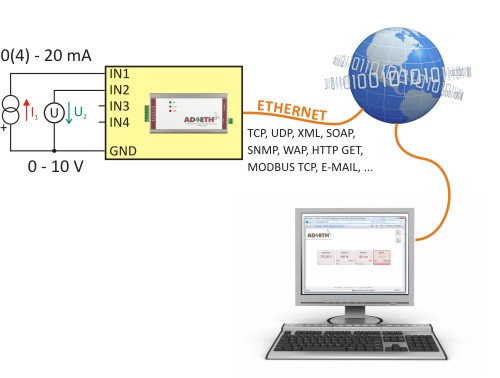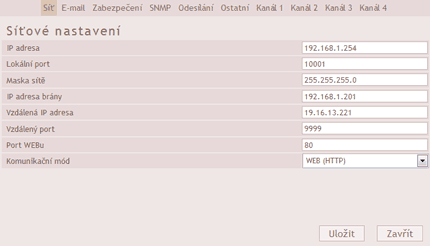How to easily measure analogue signals over RS232/485, USB or Ethernet?
The AD4 measuring converters are able to convert analogue signals ranging from 0 or 4 to 20mA or voltage between 0 and 10 V into digital form. They have been developed mainly to process output signals from various sensors. The measured values are then transferred to a superior system in digital form.
Individual versions of the measuring modules of the AD4 series differ in their communication interface – the AD4RS modules transfer the measured values via the RS485 or RS232 line, the AD4USB version connects to a PC via the USB interface and the AD4ETH version has been designed to transfer data over the Ethernet.

Fig.1 – Measuring converters of AD4 series featuring RS232 / RS485, USB and Ethernet interfaces.
For further processing or displaying, the signal ranging from 0(4) to 20mA, representing the measured physical quantity, needs to be converted into a digital signal and transferred into a superior system, for example a PC. This is the purpose of the new measuring modules of the AD4 series, which have been developed in three versions under the denominations of AD4RS, AD4USB and AD4ETH.
The measuring modules of the AD4 series (Fig. 1) are A/D converters enabling the user to measure up to four current signals ranging from 0(4) to 20 mA or voltage between 0 and 10 V. The measured values are then transferred to a superior system in digital form. Individual versions differ in their communication interface – the AD4RS module transfers the measured values via the RS485 or RS232 line, the AD4USB version communicates with PC via USB and the AD4ETH version has been designed to transfer data over the Ethernet.

Fig.2 – Arrangements of the measuring devices incl. transfer of results over the Internet
Except for minor details, the features of all the versions are identical. The measuring converters of the AD4 series contain 4 inputs for the measurement of current or voltage. The maximum measuring rate is twice in a second, which makes the devices especially suitable for measuring physical quantities. All measuring terminals have a joint grounding which is galvanically separated from other parts of the device. The AD4USB version does not require a separate power supply, while the other versions can be powered by voltage ranging from 6 to 35V. The measuring modules of the AD4 series are supplied in robust metal design and are mountable on the DIN rail. Measured signals are connected through a slip-on terminal block (bus). Light indicators provide information about power supply, measuring and input range exceeding.
The input range is always divided into 10.000 segments. However, it is possible for each input to enter the coefficients of the following linear equation Y=a + k x M, where Y represents the resulting value and M represents the measured value within the range of 0 to 10.000. Thus it is possible to obtain a real value in the required natural unit. Let’s say we have a relative pressure sensor with the range of 0 to 100 kPa and output of 4 to 20 mA. In the AD4 module we choose a corresponding input range, i.e. 4 to 20 mA and enter the following coefficients: a=0, k=10. As a result, the AD4 will send results ranging between 0 and 100,000, which corresponds to pressure measured in Pascal. Even though such calculations can also be performed by the superior system, conversions carried out directly in the measuring device prevent mistakes and are largely applicable mainly in the version with Ethernet communication. The Ethernet version of AD4ETH enables the used to simply enter the range by setting the maximum and minimum values and the constants for the linear equations are calculated automatically accordingly.
The AD4RS measuring converter with the RS485 interface is suitable for extensive measuring systems thanks to its ability to transfer data over long distances, while the AD4USB version has – on the contrary – been designed for laboratories and small-scale measuring systems based on a laptop. It can also be connected to PDA computers with the USB Host port. Data are transferred using the Spinel protocol. It is an open and well-described communication protocol with available development tools, DLL libraries and examples for programmers. Upon request, it is possible to supply AD4 converters with Modbus RTU or Modbus TCP protocols.

Fig.3 – WEB interface in the Ethernet version (AD4ETH)
The most interesting is AD4ETH, i.e. the measuring module with Ethernet interface. It is able to read the values in the same way as the other versions, but it offers a number of other functions enabled by its Ethernet connectivity:
- Internal web page (Fig. 3.) with measures values. All parameters are set via the WEB interface (Fig. 4.). For example, it is possible to set the names and conversion of the measured values, so that the measured physical quantities can be displayed in natural units. The WEB page is available in Czech and English.
- The ongoing measurements can also be easily checked via a mobile phone or PDA thanks to a simple WAP page.
- E-mail – the AD4ETH measuring module will send an email whenever reaching a preset value of the chosen physical quantity in order to inform the user of e.g. an emergency.
- XML file – a widely used format which can be read by many programs. AD4ETH is able to send the measured values in the XML format using the SOAP protocol.
- SNMP protocol – a widely used protocol for the control and monitoring of various physical quantities. The AD4ETH module is even able to send a SNMP trap when the preset conditions are met. Many companies use the SNMP protocol universally. Any sensor that can use it can be easily incorporated into the system.
- Other protocols can be supplied upon request (for example MODBUS TCP and RTU or special industrial protocols).

Fig.4 - Configuration menu of the Ethernet version
The measured values from the AD4 modules will probably be used as input data for superior systems, regulators, monitoring devices etc. However, it is also possible to use the Wix program, which is provided free of change and which enables each input to get a special name and to display and store measured values in set intervals.
The measuring modules of the AD4 series can be borrowed for trial use and our technicians will be pleased to help you with their application. If you are a producer or supplier of sensors with analogous output, we have prepared very interesting prices for you.

